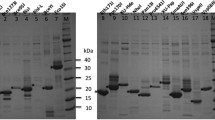Abstract
A new restriction endonuclease, named Splase, was constructed by genetically fusing the DNA-cleavage domain of the restriction endonucleaseFokI with the zinc-finger DNA-binding domain of the transcription factor Sp1. The resulting protein was expressed inEscherichia coli., partially purified, and shown to selectively digest plasmid DNA harboring consensus Sp1 sites. Splase was also shown to selectively digest the long terminal repeat of the HIV-1 DNA at Sp1 sites. Splase recognizes a 10-bp DNA sequence and hydrolyzes phosphodiester bonds upstream of the binding sequence. The binding specificity of Splase makes this a “rare cutter” restriction enzyme which could be valuable in creating large DNA fragments for genome sequencing projects. The result also presents the opportunity to create other restriction enzymes by altering the binding specificity of the zinc-finger recognition helix.
Similar content being viewed by others
References
Chen, C., and Sigman, D. S. (1987).Science 237, 1197–1201.
Chen, C., and Sigman, D. S. (1988).J. Am. Chem. Soc. 110, 6570.
Chen, C., Gorin, M., and Sigman, D. S. (1993).Proc. Natl. Acad. Sci. USA 90, 4206–4210.
Choo, Y., and Klug, A. (1994).Proc. Natl. Acad. Sci. USA 91, 11163–11172.
Coray, D. R., Pei, D., and Schultz, P. G. (1989a).Biochemistry 28, 8277–8286.
Coray, D. R., Pei, D., and Schultz, P. G. (1989b).J. Am. Chem. Soc. 111, 8523–8525.
Deng, T., Noel, J. P., and Tsai, M.-D. (1990)Gene 93, 229–234.
Gendelman, H. E., Phelps, W., Feigenbaum, L., Ostrove, J. M., Adachi, A., Howley, P. M., Khoury, G., Ginsberg, H. S., and Martin, M. A. (1986).Proc. Natl. Acad. Sci. USA 83, 9759–9763.
Hochuli, E., Debeli, H., and Schacher, A. (1987).J. Chromatogr. 411, 177–184.
Jones, K. A., Kadonaga, J. T., Luciw, P. A., and Tjian, R. (1986).Science 232, 755–759.
Kadonaga, J. T., Carner, K. R., Masiarz, F. R., and Tjian, R. T. (1987).Cell 51, 1079–1090.
Kim, Y.-G., and Chandrasegran, S. (1994).Proc. Natl. Acad. Sci. USA 91, 883–887.
Kim, Y., Cha, J., and Chandrasegaran, S. (1996).Proc. Natl. Acad. Sci. USA 93, 1156–1160.
Kriwacki, R. W., Schultz, S. C., Steitz, T. A., and Caradonna, J. P. (1992).Proc. Natl. Acad. Sci. USA 89, 9759–9763.
Li, L., and Chandrasegran, S. (1993).Proc. Natl. Acad. Sci. USA 90, 2764–2768.
Li, L., Wu, L. P., and Chandrasegran, S. (1992).Proc. Natl. Acad. Sci. USA 89, 4275–4279.
Maxam, A. M., and Gilbert, W. (1980).Meth. Enzymol. 65, 499–560.
Pan, Q. C., Landgraf, R., and Sigman, D. S. (1994).Mol. Microbiol. 12(3), 335–342.
Pavletich, N., and Pabo, C. (1991).Science 252, 809–817.
Pei, D., and Schultz, P. G. (1994).J. Am. Chem. Soc. 112, 4579–4580.
Pelham, H., and Brown, D. (1980).Proc. Natl. Acad, Sci. USA 77, 4170–4174.
Perlman, P. S., and Butow, R. A. (1989)Science 246, 1106–1109.
Skowron, P., Kaczorowski, T., Tucholski, J., and Podhajska, A. (1993).Gene 125, 1–10.
Sugisaki, H., and Kanazawa, S. (1981).Gene 16, 73–78.
Sutton, C., Maxumder, A., Chen, C., and Sigman, D. S. (1993).Biochemistry 32, 4225–4230.
Yonezawa, A., and Sugiura, Y. (1994).Biochim. Biophys. Acta 1219, 369–379.
Author information
Authors and Affiliations
Corresponding author
Rights and permissions
About this article
Cite this article
Huang, B., Schaeffer, C.J., Li, Q. et al. Splase: A new class IIs zinc-finger restriction endonuclease with specificity for Sp1 binding sites. J Protein Chem 15, 481–489 (1996). https://doi.org/10.1007/BF01886856
Received:
Published:
Issue Date:
DOI: https://doi.org/10.1007/BF01886856




